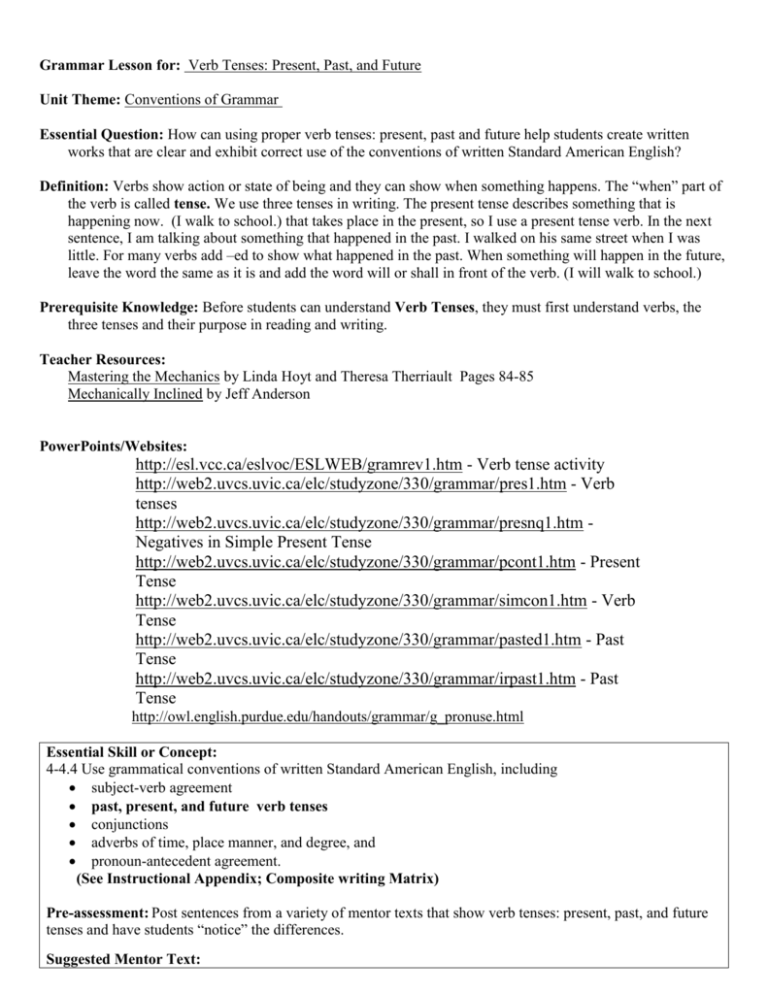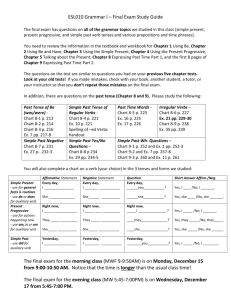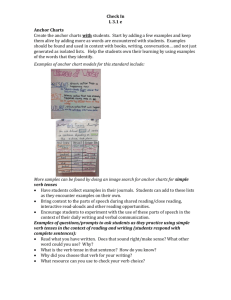Essential Question: How can using proper verb tenses
advertisement

Grammar Lesson for: Verb Tenses: Present, Past, and Future Unit Theme: Conventions of Grammar Essential Question: How can using proper verb tenses: present, past and future help students create written works that are clear and exhibit correct use of the conventions of written Standard American English? Definition: Verbs show action or state of being and they can show when something happens. The “when” part of the verb is called tense. We use three tenses in writing. The present tense describes something that is happening now. (I walk to school.) that takes place in the present, so I use a present tense verb. In the next sentence, I am talking about something that happened in the past. I walked on his same street when I was little. For many verbs add –ed to show what happened in the past. When something will happen in the future, leave the word the same as it is and add the word will or shall in front of the verb. (I will walk to school.) Prerequisite Knowledge: Before students can understand Verb Tenses, they must first understand verbs, the three tenses and their purpose in reading and writing. Teacher Resources: Mastering the Mechanics by Linda Hoyt and Theresa Therriault Pages 84-85 Mechanically Inclined by Jeff Anderson PowerPoints/Websites: http://esl.vcc.ca/eslvoc/ESLWEB/gramrev1.htm - Verb tense activity http://web2.uvcs.uvic.ca/elc/studyzone/330/grammar/pres1.htm - Verb tenses http://web2.uvcs.uvic.ca/elc/studyzone/330/grammar/presnq1.htm Negatives in Simple Present Tense http://web2.uvcs.uvic.ca/elc/studyzone/330/grammar/pcont1.htm - Present Tense http://web2.uvcs.uvic.ca/elc/studyzone/330/grammar/simcon1.htm - Verb Tense http://web2.uvcs.uvic.ca/elc/studyzone/330/grammar/pasted1.htm - Past Tense http://web2.uvcs.uvic.ca/elc/studyzone/330/grammar/irpast1.htm - Past Tense http://owl.english.purdue.edu/handouts/grammar/g_pronuse.html Essential Skill or Concept: 4-4.4 Use grammatical conventions of written Standard American English, including subject-verb agreement past, present, and future verb tenses conjunctions adverbs of time, place manner, and degree, and pronoun-antecedent agreement. (See Instructional Appendix; Composite writing Matrix) Pre-assessment: Post sentences from a variety of mentor texts that show verb tenses: present, past, and future tenses and have students “notice” the differences. Suggested Mentor Text: Dear Mr. Henshaw by Beverly Cleary , Because of Winn Dixie by Kate DiCamillo, Tales of a Fourth Grade Nothing Lesson Outline: READ ALOUD/MINI-LESSON Modeling/Mini Lesson Create a chart on the Smart Board or the dry erase board. PAST PRESENT FUTURE. Ask the students to place the following events in the correct column. Write the events on the chart as the students respond. Your birthday Barrack Obama’s presidency Abraham Lincoln’s presidency First woman president Spring Break July 4th 2009 January 1st2009 First man on the moon First man on Mars After the events are written on the chart, ask the students to choose one of the events and write a sentence about it. Then have the students share their sentences. Write the verbs from the sentences as the students share their work. After listing the verbs (past, present, and future) ask the students which verbs tell that something happened in the past, present and future. Point out that verbs tell not only what happened, but they also tell when. Choose a verb as an example: Today I am teaching. Yesterday I taught. Tomorrow, I will teach. Review the terms present, past and future. How will I introduce and explain this skill so that students will understand the how and why? (inductive method, mini-lecture,demonstration, notes, etc.) Read aloud pgs 10- 11. of the mentor text (Dear Mr. Henshaw). Stop and look at the author’s use of verbs. Have the students find examples of each type of verb in the sentences. Have the students explain how the past and future tenses were formed. . Read a few more pages, discuss how regular verbs, add –ed to show past tense. Add the word will or shall to the verb to show the future tense. SHARED WRITING/READING How will I model this skill for my students? (exemplars and/or demonstrations) See Day 1 pg. 84 in Mastering the Mechanics 4-5 by Linda Hoyt Create an anchor chart – see sample GUIDED WRITING/READING How will I provide opportunities for guided practice? See Day 2 pg. 84 in Mastering the Mechanics 4-5 by Linda Hoyt Write this paragraph on the board or use the Smart board. The dog saw the cat and he will bark. He runs down the driveway and jumped on the cat’s back. The cat howls and clawed the dog. The dog gets a bad scratch on his face and will run back home. Have the students proofread the paragraph. Have the students circle the errors, and then list the errors on the board. saw will bark runs jumped howls clawed gets will run Discuss that some of the verbs are present, some are past tense and some are future tense. Have the students rewrite the paragraph so that all of the verbs are in the same tense. Have the students share their paragraphs. ASSESSMENT How will I monitor/gauge students’ understanding of the skill? (formative assessment) Use the passage on pg. ____ from the mentor text and ask students to identify places where the verb tense is correct. Ask them why this is important and how the writing would be different if the writing. PASS Format: See samples Give groups of students passages and ask them to identify the verbs as present, past or future tense. Give groups of students passages that lack correct verb tenses and ask them to “edit” the passage. Give students a sample passage that has sentences that lack correct verb tenses. Use the question stem: What is the correct way to write/edit this sentence? Write this paragraph on the board or use the Smart board. See “Assess the Learning” pg. 85 in Mastering the Mechanics 4-5 by Linda Hoyt During a conference pinpoint a sentence and ask the writer why he or she chose to use a particular tense. Then, ask the student to change the verb to a different tense and explain how to change it. INDEPENDENT PRACTICE WRITING/READING How will students independently practice using the skill in their writing? See Day 3 pg. 85 in Mastering the Mechanics 4-5 by Linda Hoyt Ask students to write, and then select a sample to model proofreading for verb tenses. Have the student look for clues that signal the use of present, past and future tenses. Have the students point out what they do to change the verb to indicate action in the past, present and future tenses. During conferences pinpoint a sentence and ask the writer to change the verb to a different tense and explain how to change it. DIFFERENTIATION How will I adapt or differentiate this lesson for grade and skill level? Guided groups, independent writing Have the students create a list of two –word sentences where the subject is in the third person singular. Then have the students change the verb to a different tense. REFLEXTIONS How will I engage students in a reflection of how this skill has developed and how it has helped each of them become a more effective writer? Have students use the State Writing Rubric to evaluate their writing. Have students journal in their writer’s notebook the purpose of using correct verb tense and how it helps them become a better writer. Have students identify powerful verbs in mentor texts and write sentences on sentence strips to post around the room. Discuss the sentences focusing on verb tense. Then reflect on how sing correct verb tenses impacts on their writing.








